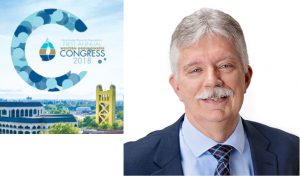Tony Morgan to Present on Groundwater Sustainability Plans and Information Discovery at Groundwater Resources Association of California Conference
 DBS&A Vice President / Principal Hydrogeologist, Tony Morgan, P.G., C.Hg., will present “The Unknown Unknowns – Groundwater Sustainability Plans (GSPs) and Information Discovery” at the Groundwater Resources Association of California (GRAC) First Annual Western Groundwater Congress. Mr. Morgan’s presentation will be part of the technical session on “Data: The Essential Element of SGMA, which will highlight the importance of data collection in Sustainable Groundwater Management, dealing with issues associated with data collection and analysis, and utilizing data to address key requirements of SGMA. Learn more about Tony and DBS&A’s SGMA services.
DBS&A Vice President / Principal Hydrogeologist, Tony Morgan, P.G., C.Hg., will present “The Unknown Unknowns – Groundwater Sustainability Plans (GSPs) and Information Discovery” at the Groundwater Resources Association of California (GRAC) First Annual Western Groundwater Congress. Mr. Morgan’s presentation will be part of the technical session on “Data: The Essential Element of SGMA, which will highlight the importance of data collection in Sustainable Groundwater Management, dealing with issues associated with data collection and analysis, and utilizing data to address key requirements of SGMA. Learn more about Tony and DBS&A’s SGMA services.
Taking place September 25 to 27, 2018 in Sacramento, California, GRA’s premier technical event will focus on Western groundwater quality and groundwater resources, and will boast world-class technical presentations on Water Resources, Sustainable Groundwater Management Act (SGMA) legislation, Contaminants, and other special topics. Click here to learn more about the event.
More about Tony’s presentation: The Unknown Unknowns—GSPs and Information Discovery.
Unknown Unknowns (U-U), sometimes called unidentified risks or blind spots, are often not a part of project management (e.g., GSP development) or are sometimes accounted for as a nonspecific “project contingency”. A U-U is sometimes thought to be impossible to find or imagine in advance.
To minimize these blind spots, it is frequently recommended to seek perspectives on the process from others who have experienced similar projects and to test those implicit assumptions used as framework to a project. However, GSP preparation is a very new activity and there no “gray- haired GSP authors/mentors” from which to seek GSP-specific guidance. Parts of a GSP are fairly routine (e.g., establish a water balance based on existing data, review laboratory data to identify water quality concerns) for hydrogeologists or other water scientists, but the synthesis of these data into a useful form to address sustainability criteria, measurable objectives, and minimum thresholds is a largely uncharted path.
Implicit assumptions are an interesting attribute of U-U. If a technical advisory committee for a GSP is, for example, composed of entirely hydrogeologists, then the ability to anticipate the U-U can be constrained by the similarity of their experiences. The addition of an engineer, biologist, or land use professional may provide a perspective that challenges “the way it has always been understood” and thereby offer insights that could minimize the likelihood of a U-U that could impede a project’s progress.
Even with the realization that U-U may exist, the blind spots are not likely to be eliminated as the GSP development process unfolds. Several decades of hydrogeological investigations dealing with the Oxnard Plain area in Ventura County have generated an impressive accumulation of data, but U-U have been identified. The U-U from GSP development actions and related technical studies in Ventura County, California, include, for example, the discovery of undocumented faults that had little apparent impact on groundwater flow and faults that were likely causal factors in elevated groundwater temperatures and localized, stable potentiometric levels, the identification of the importance of aquitard leakage and its contribution to the preferential migration of sea-water intrusion, the recognition of multiple sources of chloride that were historically attributed to sea-water intrusion, and the detection of differing potentiometric heads within a single hydrostratigraphic unit.
An upfront recognition and communication that U-U are probably going to manifest themselves during the GSP development process helps stakeholders understand that rarely are perfect data available and that blind spots, while undesirable, are not likely to be eliminated, but can be minimized.
